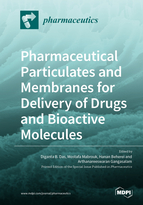Pharmaceutical Particulates and Membranes for Delivery of Drugs and Bioactive Molecules
A special issue of Pharmaceutics (ISSN 1999-4923).
Deadline for manuscript submissions: closed (31 December 2019) | Viewed by 59585
Special Issue Editors
Interests: water and soil security; wastewater treatment
Special Issues, Collections and Topics in MDPI journals
Interests: polymer membrane; membrane modification; biomolecule separation
Interests: drug delivery systems; biomaterials; tissue engineering; nanomaterials; hydrogels
Special Issues, Collections and Topics in MDPI journals
Interests: bioceramics; biopolymers; biocomposites; nanomaterials; biochemical engineering; tissue engineering and drug delivery
Special Issue Information
Dear Colleagues,
We would like to invite you to contribute to this Special Issue, entitled "Pharmaceutical Particulates and Membranes for Delivery of Drugs and Bioactive Molecules".
A drug release profile is a consequential factor for nanoparticle application, directly related to drug stability and therapeutic results, as well as formulation development. Pharmaceutical particulates of different sizes and shapes (e.g., liposomes, oil-in-water emulsions, polymeric nano- and microspheres, metallic nanoparticles (NPs), such as gold, silver, and iron oxide crystals, core-shell hybrid NPs) offer many diagnostic and therapeutic applications. Membranes are also extensively utilized in many applications. They are very beneficial, especially for the distribution of macromolecular drugs and biopharmaceutical drugs (peptides, proteins, antibodies, oligonucleotides, plasmids, and viruses) with physicochemically and pharmacokinetically vulnerable.
Delivery of drugs and bioactive molecules using particulates and membranes has gained a great deal of attention for various applications, such as the treatment of secondary infections, cancer treatment, skin regeneration and orthopaedic applications, antimicrobial drug delivery, and others. In addition, several production techniques have been utilized for the fabrication of particulates and membranes in the last decade, which include lyophilization, micro-emulsion, nano-spray dryer, nano-electrospinning, slip casting and 3D printers. Therefore, pharmaceutical particulates and membranes possess excellent prospects to deliver drugs and bioactive molecules with the potential to improve new delivering strategies like sustained and controlled release.
Taking these into consideration, this Special Issue invites articles dealing with the following topics:
1- Particulates preparation techniques (nano- to micron- scale particulates)
2- Membranes fabrication techniques (e.g., nano-electro spinner, slip casting, 3D printers).
3- In vitro and in vivo studies of pharmaceutical particulates or membranes.
4- Modelling and optimization of drug release from pharmaceutical particulates or membranes
If sufficient numbers of papers are published in the planned Special Issue (≥10), then we will also compile an edited book containing the papers.
We look forward to receiving your contributions.
Sincerely,
Dr. Diganta B. Das
Prof. G Arthanareeswaran
Dr. Mostafa Mabrouk
Prof. Hanan H. Beherei
Guest Editors
Manuscript Submission Information
Manuscripts should be submitted online at www.mdpi.com by registering and logging in to this website. Once you are registered, click here to go to the submission form. Manuscripts can be submitted until the deadline. All submissions that pass pre-check are peer-reviewed. Accepted papers will be published continuously in the journal (as soon as accepted) and will be listed together on the special issue website. Research articles, review articles as well as short communications are invited. For planned papers, a title and short abstract (about 100 words) can be sent to the Editorial Office for announcement on this website.
Submitted manuscripts should not have been published previously, nor be under consideration for publication elsewhere (except conference proceedings papers). All manuscripts are thoroughly refereed through a single-blind peer-review process. A guide for authors and other relevant information for submission of manuscripts is available on the Instructions for Authors page. Pharmaceutics is an international peer-reviewed open access monthly journal published by MDPI.
Please visit the Instructions for Authors page before submitting a manuscript. The Article Processing Charge (APC) for publication in this open access journal is 2900 CHF (Swiss Francs). Submitted papers should be well formatted and use good English. Authors may use MDPI's English editing service prior to publication or during author revisions.
Keywords
- Nanoparticles, drug delivery, cancer therapy, microspheres, self-assemblies
- Polymers, copolymers, biomaterials, microparticle, nanoparticle,
- Pharmaceutical dosage forms, molecular drugs, targeted drug delivery
- Brain diseases, targeting, nanocarriers
- Intracellular drug delivery, gene transfection, controlled release
- Morphology control, nanoparticle endocytosis, biocompatibility









